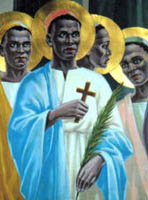Classic DACB Collection
All articles created or submitted in the first twenty years of the project, from 1995 to 2015.Lwanga, Charles (B)

Muganda Catholic Martyr. He was probably born in Buddu c. 1860, but little is known of his parentage. By birth he belonged to the Ngabi (bushbuck) clan, but members of this clan were not allowed at court by reason of their royal connection, so there he passed as a member of the Ngeye (colobus monkey) clan, the clan of his former master. He spent his early years at Kalokere in Buddu. In 1878 he entered the service of Mawulugungu, chief of Kirwayi. In 1879 this chief was transferred to Kitesa in Ssingo, and Lwanga accompanied him. In 1880 he accompanied his master on an official visit to the court to give thanks to the Kabaka for his chiefdom. Lwanga’s first interest in Christianity was aroused by some of his fellow pages who began to attend instruction classes when they visited the capital with gifts from Mawulugungu to the Kabaka. Mawulugungu died in 1882 and Lwanga went to Kitanda in Bulemezi where he joined a group of newly-baptized Catholics. On the accession of Mwanga in 1884 Lwanga entered his service and became head of the pages serving in the audience hall, and he quickly won their respect and affection. His immediate superior was Joseph Mukasa Balikuddembe. Classes for Christian instruction were held in the palace, and these Lwanga attended. In 1885 Mwanga’s wrath was turned against the Christians for they had found in their new faith an allegiance which could transcend even their allegiance to him, and he and his chiefs saw in this a threat which was capable of undermining the whole Kiganga way of life. In January 1885 three Protestants were burnt. In November, Joseph Mukasa Balikuddembe was martyred for reproving Mwanga for causing the death of Bishop Hannington. On the night of Balikuddembe’s death, Lwanga and others went to the Catholic mission and begged for baptism, and this was granted them (November 15, 1885). Lwanga now became head of the Catholic pages in Balikuddembe’s palace. A crisis occurred at the end of May, 1886, and Mwanga’s wrath against the Christian pages became ungovernable. Early in the morning of May 26th Lwanga baptised five of the neophytes when he realized that their lives were in grave danger. Shortly afterwards when Lwanga and the other pages presented themselves to the Kabaka, the Christians were told to declare themselves, and Lwanga led the group of those who did so. Other Christians were added to the group. For most, the actual martyrdrom took place some days later at Namugongo, an official place of execution. Here on June 3rd, Charles Lwanga was burnt first on a separate pyre, at a place now marked by the Church of Our Lady Queen of Martyrs, and his quiet faith was an example to those who would follow.
Louise Pirouet
This article, used by permission, was written by Louise Pirouet, as part of A Dictionary of Christianity in Uganda (Department of Religious Studies, Makerere University College, 1969), p. 47. Copies available at Africana Section, Makerere University Library (AF Q 276.761 MAK and AR/MAK/99/1); Bishop Tucker Library, Uganda Christian University and in UK at the University of Birmingham; Crowther Centre Library, CMS Oxford and Louise Pirouet Papers, Cambridge Centre of African Studies.



